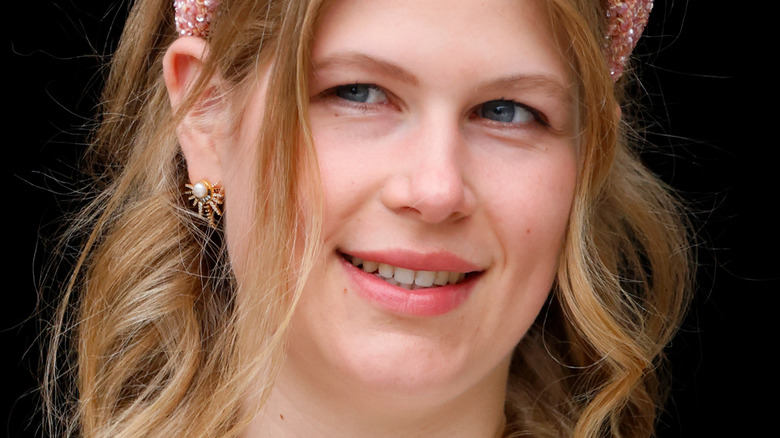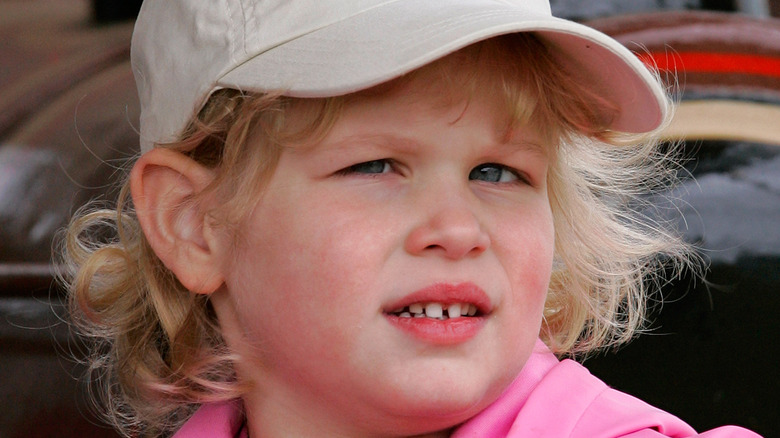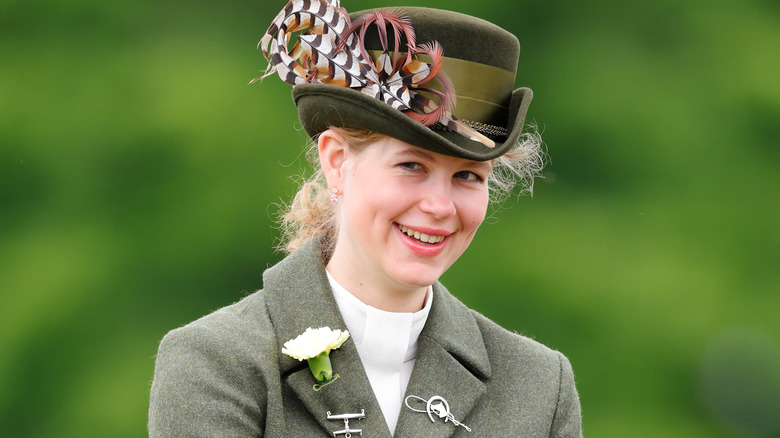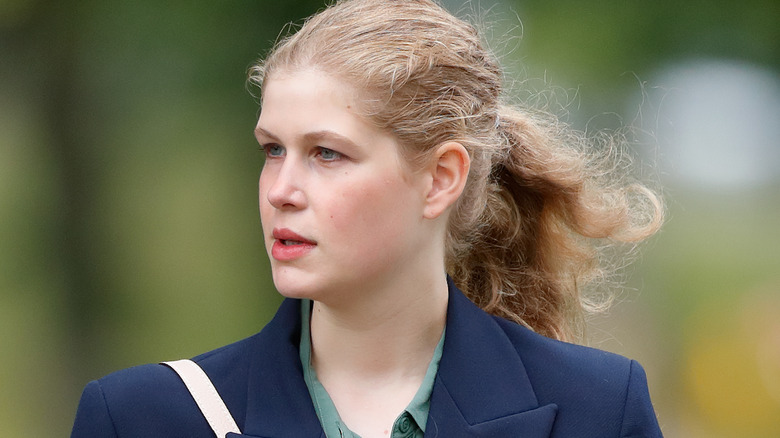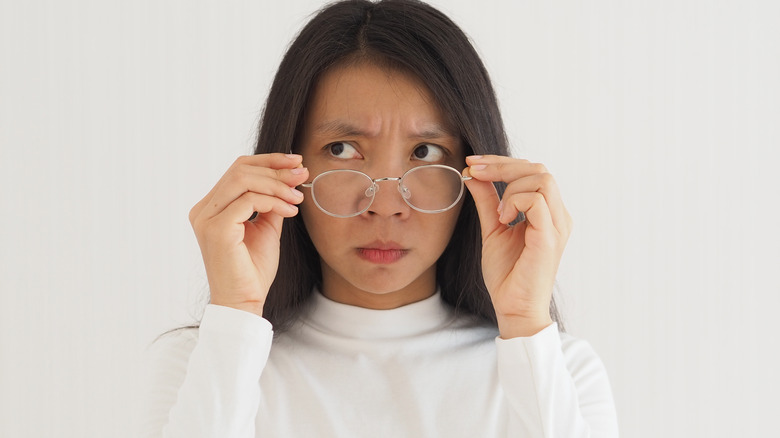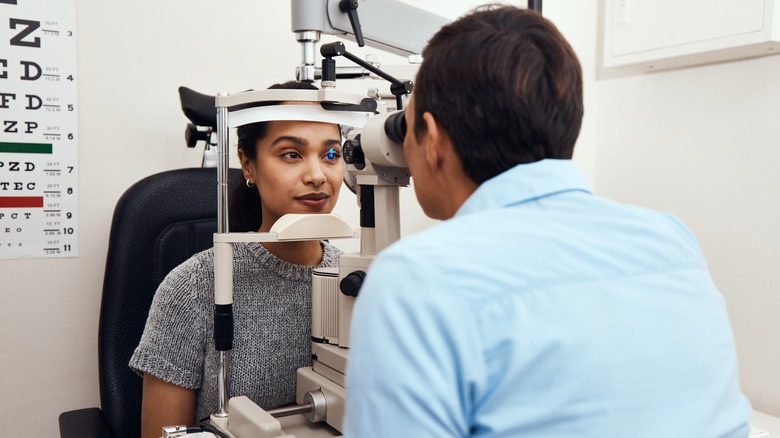Lady Louise Windsor Was Born With A Rare Health Condition. Here's What We Know About It.
If you keep a close eye on the comings and goings of the royal family, you're probably familiar with Lady Louise Windsor. She mostly keeps to herself, but we love seeing her make a public appearance every now and then. The daughter of Prince Edward and Sophie, Countess of Wessex, Louise recently made headlines when she got accepted to St Andrews University in Scotland to study English, following in Prince William's footsteps (via the Independent).
While most are aware that she's a member of the royal family, those who aren't avid fans might not know that Louise was born with a rare eye condition — although she has 20/20 vision now. The condition, which is called esotropia (also often referred to as a "squint"), meant that Louise used to have trouble with her sight when she was young. She was born prematurely, and as her mother told Express, it wasn't uncommon for premature babies to have this condition "because the eyes are the last thing in the baby package to really be finalised." Those who've been keeping tabs on the royal family might remember that Louise's eyes used to appear as if they were looking in different directions when she was a young child. Read on to discover more about this rare condition and how Louise managed to overcome it.
What exactly is esotropia?
Esotropia is a condition that affects the eyes, specifically the nerves and muscles that allow the eyes to work as a team. When a person has esotropia, these muscles and nerves don't work in tandem. This is what causes one or both eyes to turn inward. This compromises the alignment of the eyes and causes the crossed-eye look that people associate with this condition (via Cleveland Clinic). There are various types of misalignment, which collectively fall under the umbrella term strabismus. Esotropia is only one of these conditions and can affect one or both eyes.
Esotropia is actually pretty rare — the College of Optometrists in Vision Development reports that only 1%-2% of the American population has this condition. For some, their esotropia might come and go, while others experience it permanently, Medical News Today reports. Those who have intermittent esotropia only deal with symptoms when they strain their eyes by looking at objects that are either very far away or very close. Symptoms might also present when the person is sick or tired.
Lady Louise's first eye surgery at 18 months old was unsuccessful
Lady Louise Windsor's birth was quite dramatic. She had to be born via an emergency caesarian section and only weighed 4 pounds 9 ounces. Her mother Sophie, Countess of Wessex, almost died from excessive blood loss. It is thought that Louise's esotropia was a result of her premature birth. Her mother revealed in an interview with Express that Louise's squint was "quite profound" when she was small. Some outlets reported that Louise had exotropia (one or both eyes looking outward), but her mother set the record straight in the interview. "Louise was born with a squint. People have called it exotropia. It wasn't ever exotropia — that has been incorrect" (via Express).
Hello! reports that Louise first underwent surgery to correct her sight when she was only 18 months old. This was likely because her esotropia was pretty severe. She underwent a quick, 30-minute procedure, but unfortunately, the surgery wasn't successful. "It takes time to correct it. You've got to make sure one eye doesn't become more dominant than the other," her mother explained during the interview. Her esotropia didn't keep Louise from living her life, however. She still managed to do well in school and even took up horseback riding.
Lady Louise finally had successful eye surgery when she was 10
Despite the failed procedure when she was 18 months old, Lady Louise Windsor underwent another procedure to correct her esotropia in 2014 at the age of 10. This time, the surgery was successful.
Royal fans quickly noticed the change in her appearance when she appeared at the Royal Ascot for a racing event, accompanied by her parents. Others noticed that her eyes looked different when she was spotted attending church with her parents on Christmas Day that year (via the Daily Mail). Her mother, Sophie, Countess of Wessex, later told Express that Louise's "eyesight is perfect" since she underwent the second surgery.
There's speculation that Louise's esotropia inspired her mother to become involved with organizations that aim to help those experiencing vision problems. Sophie is a global ambassador of Vision 2020 and a patron of the International Agency for the Prevention of Blindness. We won't be surprised if Louise follows in her mother's footsteps once she finishes her degree at St. Andrews University.
There are different types of esotropia
The American Association for Pediatric Ophthalmology and Strabismus explains that the type of esotropia you get diagnosed with depends on a few things: How often you experience it, your age, and whether it's possible to correct it with glasses. A person can be diagnosed with either infantile esotropia, acquired esotropia, intermittent esotropia, or accommodative esotropia (via Medical News Today).
Infantile esotropia refers to esotropia diagnosed in children who are 1 year old or younger. Doctors will typically suggest the child undergo surgery to correct their vision before they turn 2 since this is when the procedure tends to be the most successful. Acquired esotropia, on the other hand, refers to esotropia that develops later in a person's life. It's typically triggered by other issues like being farsighted or having diabetes. People with acquired esotropia typically deal with double vision.
According to WebMD, some people develop intermittent esotropia. This means that the eyes sometimes struggle to cooperate together, making it challenging to focus. People with this type of esotropia usually find that their eyes can't focus on objects they're trying to see and instead focus past them. This can lead to additional issues like struggling to read, headaches, and eye strain. Accommodative esotropia, also known as refractive esotropia, is the most common, and symptoms also show up when people are trying to focus on objects. People who are farsighted and don't wear corrective lenses often develop accommodative esotropia as a result.
Causes of esotropia
We've already established that, for some, esotropia is a condition they are born with, but there are various things that can cause it to develop. Esotropia occurs when the eye muscles responsible for keeping your eyes coordinated are unable to maintain that coordination, and there are various factors and conditions that can affect the eye muscles in this way (via Cleveland Clinic).
Medical News Today notes that esotropia can be genetic, so if someone in your family has it, you have a good chance of developing it too. It's important to note that it's not a given that all family members will develop the same type of esotropia, and people from the same family might be diagnosed with various forms of strabismus.
Being born prematurely is another common cause of esotropia. Some chronic medical conditions can also cause it to develop — an overactive thyroid and diabetes are the most common culprits. Then there are also other eye disorders to take into account: Glaucoma and cataracts both have the potential to trigger this condition. Issues with the eye's optic nerve or retina can also lead to esotropia. Neurological conditions, most notably excess fluid and/or pressure on the brain, a brain tumor, or a stroke can trigger this condition. Healthline notes that other conditions that might cause esotropia include Duane syndrome (a horizontal eye movement disorder) and poor vision.
These are the symptoms to look out for
Esotropia can be fairly easy to spot if you know what to look for. Ironically, the most obvious symptom, which is eyes that look crossed and don't seem to be able to look at the same place at the same time, might not be visible to you when you look in the mirror, Healthline reports. There are other ways to recognize that you might be dealing with this condition, however.
For starters, having trouble focusing on objects that are right in front of you is a cause for concern. You might notice that you can't see something well with both eyes but can focus on it if you use only one eye. The UT Southwestern Medical Center notes that the most common symptom people with adult-onset esotropia experience is double vision. Additionally, they might notice that their range of vision becomes smaller. Experiencing blurry vision is also common. You might also find that your depth perception starts to decrease.
In the case of children, however, symptoms are often not as obvious — at least not to them. Because their brains are still developing, they will accommodate for the lack of vision by trying to obscure one image to prevent double vision. Parents might notice that the child's eyes look crossed — this symptom could be present in either one or both eyes. In some cases, one eye crosses way more than the other, and this is often referred to as a lazy eye.
How is esotropia diagnosed?
If you or your child show any symptoms of esotropia, it's crucial you see an ophthalmologist so they can diagnose the problem. Typically, your visit will kick off with a discussion of your medical and family history. Then you'll be subjected to an eye exam that will tell the doctor how your eyes focus and move (via Cleveland Clinic).
The UT Southwestern Medical Center explains that the vision test consists of reading an eye chart. In the case of children, the doctor will typically only observe how their eyes react when asked to focus on something. You can also expect to undergo a refraction test — your doctor will test how well your eyes can focus light by using various corrective lenses. A motor sensory exam will be conducted after the vision test. This exam includes an extraocular muscle movement evaluation and an ocular alignment test. You'll also undergo Cycloplegic refraction tests. This is done by placing dilating eyedrops in the eye to inspect how it refracts light when it's not autofocusing.
Other tests include a slit-lamp exam — which allows the doctor to take a look inside your eye and see a detailed picture of its structure. They might also test how your pupils dilate to gauge whether your eye's internal structures are functioning properly. Last but not least, you may undergo a fundus examination — this consists of using a special microscope to examine the retina in detail.
Infant versus adult esotropia
As you might have gathered by now, esotropia does not solely occur in children, and many adults deal with this eye condition as well. The difference lies in how it's treated — treatment varies depending on the patient's age. The UT Southwestern Medical Center reports that esotropia can sometimes be spotted in infants, while other children only start presenting symptoms when they're between the ages of 1 and 8. The esotropia can be intermittent or constant. Healthline suggests that, if you have a family history of strabismus, you take your child for a precautionary eye exam at a pediatric ophthalmologist or optometrist. Experts can pick up any irregularities before they become a problem. The earlier esotropia is detected, the sooner it can be treated to prevent any complications like vision loss. In many cases, severe esotropia in children will be corrected through surgery.
Even if you never dealt with esotropia symptoms as a child, you might start to develop them when you're an adult. Experiencing double vision is usually the first telltale sign. This might become a problem when you are busy doing things that require your eyes to be super focused, like reading, writing, driving, taking part in sports, or when you're doing specific tasks at work. Unlike children, adults who develop esotropia usually don't require surgery. Undergoing eye therapy or getting prescription glasses typically helps clear up the problem.
Various treatment options exist for esotropia
While dealing with esotropia can be pretty daunting, various treatment options are available to help people overcome this condition and regain their normal vision. Healthline explains that the type of treatment your doctor recommends will depend on how severe your esotropia is, whether you experience it in one or both eyes, and how long you've been dealing with the condition.
If esotropia is severe, a doctor will likely recommend surgery to correct the condition. It's important to note, however, that surgery is usually only recommended when the patient is an infant. It's not a common treatment option for adults, though there may be exceptions. Surgery focuses on lengthening the muscles surrounding the eyes, which then helps to straighten them. Another common treatment option is prescription glasses. They can work to correct farsightedness and help to align the eyes correctly. WebMD notes that doctors might sometimes prescribe prism lenses, which control the amount of light that can enter the eye and as a result can work to straighten it.
Another simple treatment is eye exercises. This focuses on strengthening the muscles of the affected eye, usually by obscuring the working eye with an eyepatch, forcing the "lazy" eye to work and build endurance. This can result in improved alignment. Some doctors prescribe eye drops and even ointments to help the eyes align properly. Another, less common treatment is Botox injections. This treatment option is only considered when the esotropia isn't severe.
Forgoing treatment can pose some serious risks
Esotropia isn't something that will usually go away on its own — it needs to be treated by medical professionals. WebMD warns that forgoing treatment will only cause the condition to become worse over time. Children who present esotropia symptoms after they turn 3 or 4 years old should be taken to see an eye specialist as soon as possible. The longer the eyes are out of alignment, the more issues may pop up, and the child might start to experience other symptoms such as headaches, eye strain, and blurry vision that start to interfere with their daily life. They might also begin to complain of double vision and experience poor 3D vision.
It is vital that esotropia gets treated as soon as symptoms show up. This is because esotropia which is left unchecked beyond the age of 9 can lead to permanent blindness.
When to see a doctor
Keeping tabs on your eyesight as well as your child's is vital. If you start to notice that your child seems to move objects a certain way so they can see them better, you should definitely pay attention, especially if you notice that they appear to squint a lot when they try to focus on something, Cleveland Clinic warns. Of course, the same rule applies to you — if you notice any changes in your vision, it's time for a visit to the eye doctor.
If your newborn baby's eyes seem to turn inward, chances are they may have esotropia. Some infants have intermittent esotropia, which can resolve on its own, but anytime you start to notice that the baby's eyes remain crossed, you should take them for an eye exam. While esotropia on its own isn't life-threatening, it's imperative to see a doctor immediately if your or your child's eyes suddenly become misaligned — this can be a sign of another, potentially dangerous, underlying condition. The same rule applies if your child's eyes start to look crossed after they sustain an injury. It's always best to speak to your doctor if any concerning symptoms occur, rather than waiting to see if they resolve on their own.
